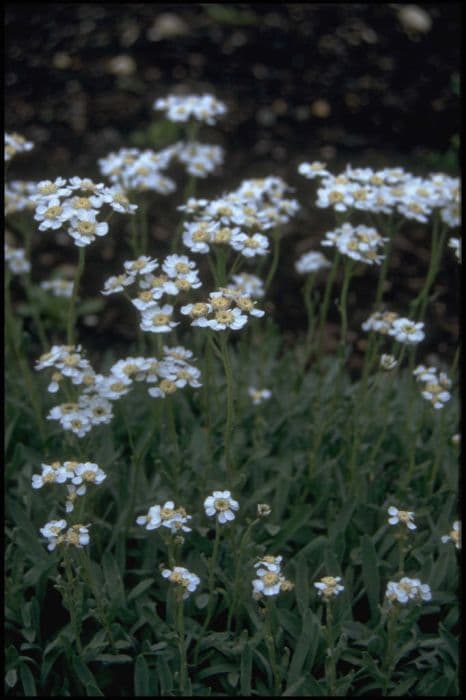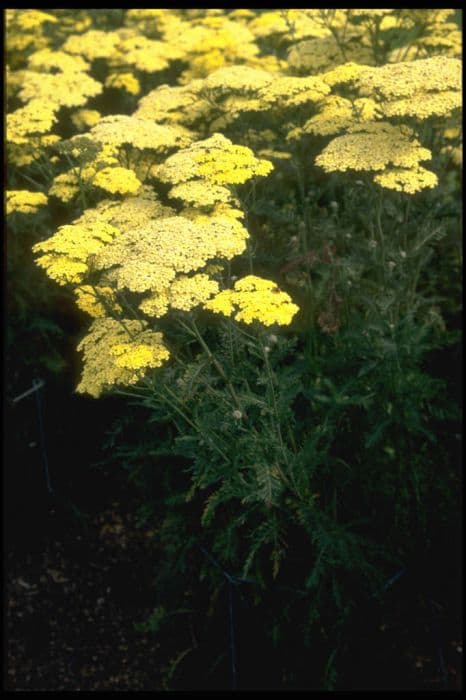African Daisy Osteospermum jucundum 'Blackthorn Seedling'

ABOUT
Osteospermum jucundum 'Blackthorn Seedling', commonly known as African daisy, is a striking flowering plant known for its daisy-like appearance. The plant showcases a profusion of blooms that typically have a unique color blend. The petals are spoon-shaped and arrayed in a radial pattern around a central disc. While the specific 'Blackthorn Seedling' variety may have unique color attributes, African daisies in general display a wide range of hues including pinks, purples, whites, and yellows, often with a contrasting eye in the center of the bloom. The leaves of the African daisy are typically dark green and have a glossy texture, which forms a lush background and highlights the vibrancy of the flowers. The foliage can be narrow to broadly lance-shaped and sometimes presents with fine teeth along the edges. The overall impression of the African daisy is one of a fresh, bright, and cheerful plant that adds color and a lively feel to any setting where it is grown.
About this plant
 Names
NamesFamily
Asteraceae
Synonyms
African Daisy, South African Daisy, Cape Daisy, Blue-Eyed Daisy
Common names
Osteospermum jucundum, Dimorphotheca jucunda.
 Toxicity
ToxicityTo humans
African daisy (Osteospermum jucundum 'Blackthorn Seedling') is generally considered non-toxic to humans. However, it is always recommended that no plant material should be ingested unless it is known to be edible. Normally, ingestion of non-toxic plants might cause mild stomach upset due to the fibrous plant material, which is not meant for human digestion.
To pets
African daisy (Osteospermum jucundum 'Blackthorn Seedling') is also generally considered non-toxic to pets. It is not known to cause serious harm if ingested by animals such as dogs and cats. Nevertheless, ingestion of any plant can potentially lead to gastrointestinal upset in pets, including symptoms like vomiting or diarrhea. Therefore, it is still best to prevent pets from eating plants unnecessarily.
 Characteristics
CharacteristicsLife cycle
Perennials
Foliage type
Evergreen
Color of leaves
Green
Flower color
Mixed
Height
1-2 feet (30-60 cm)
Spread
1-2 feet (30-60 cm)
Plant type
Herb
Hardiness zones
9
Native area
South Africa
Benefits
 General Benefits
General Benefits- Aesthetic Appeal: Osteospermum, commonly known as African Daisy, has attractive daisy-like flowers that can enhance the visual appeal of gardens and landscapes.
- Low Maintenance: African Daisies are known for their drought tolerance, requiring minimal watering and care once established, making them an ideal choice for low-maintenance gardens.
- Extended Blooming: They have a long blooming season, typically from spring to fall, providing long-lasting color in the garden.
- Attracts Pollinators: The flowers attract bees, butterflies, and other beneficial insects, promoting biodiversity and aiding in the pollination of nearby plants.
- Versatile Usage: Suitable for borders, ground cover, containers, and as cut flowers, offering a wide range of gardening and decorative applications.
- Wide Range of Colors: They come in a variety of colors and patterns, allowing gardeners to choose the perfect shades to complement their outdoor spaces.
- Heat Tolerance: African Daisies tolerate heat well, making them a great choice for sunny spots in the garden where other plants might struggle.
- Frost Tolerance: They can handle light frost, which extends their growing season in regions with cooler climates.
- Soil Adaptability: Osteospermum is adaptable to a range of soil types, though they prefer well-draining soil.
 Medical Properties
Medical PropertiesThis plant is not used for medical purposes.
 Air-purifying Qualities
Air-purifying QualitiesThis plant is not specifically known for air purifying qualities.
 Other Uses
Other Uses- Osteospermum 'Blackthorn Seedling', commonly known as African Daisy, can be used in floral arrangements, adding a striking color contrast and texture to bouquets.
- African Daisy acts as a companion plant in vegetable gardens, potentially helping to attract beneficial insects that prey on garden pests.
- The vibrant flowers can be used as a natural dye, providing shades of purple and blue for textiles or art projects.
- Pressed African Daisy flowers can be used in craft projects, such as making bookmarks, greeting cards, or decorative phone cases.
- The attractive foliage and flowers can serve as inspiration for artists and designers, influencing patterns in fashion or home decor.
- African Daisies can be used in educational settings to teach children about plant biology and the importance of pollinators in ecosystems.
- The petals of African Daisy could potentially be used in a potpourri mix, adding color and a light fragrance to a room.
- When planted in containers or hanging baskets, African Daisy can be an element of portable gardens for urban settings with limited space.
- The plant's ability to thrive in harsh conditions makes it a useful study subject for research on drought-tolerant horticulture practices.
- As a groundcover, African Daisies can be used in xeriscaping, a landscaping method that reduces the need for irrigation.
Interesting Facts
 Feng Shui
Feng ShuiThe African Daisy is not used in Feng Shui practice.
 Zodiac Sign Compitability
Zodiac Sign CompitabilityThe African Daisy is not used in astrology practice.
 Plant Symbolism
Plant Symbolism- Perseverance: The Cape Daisy, as Osteospermum jucundum 'Blackthorn Seedling' is commonly known, is a hardy plant that can thrive in challenging conditions, symbolizing the ability to persist through difficulties.
- Cheerfulness: With its bright and jovial flowers, the Cape Daisy represents happiness and positive energy, often used to bring a sense of joy to gardens and homes.
- Attraction: The Cape Daisy's vibrant colors and unique appearance make it a symbol of attraction, drawing in both admiration and beneficial insects like bees.
- Hope: Often blooming in tough conditions, the Cape Daisy can symbolize hope and the promise of new opportunities or beginnings.
 Water
WaterAfrican daisy should be watered deeply but infrequently to encourage a strong root system. Allow the top inch of soil to dry out between waterings, typically this means watering once every week during the growing season. In cooler weather or when the plant is not actively growing, reduce the frequency to every two to three weeks. When watering, aim for about one gallon of water per plant, ensuring it's distributed evenly around the base without wetting the foliage to prevent fungal diseases.
 Light
LightAfrican daisy thrives in full sun, requiring at least six to eight hours of direct sunlight per day for optimal growth and flowering. An ideal spot would be in a south-facing garden or a balcony that receives ample sunlight throughout the day. While it can tolerate partial shade, too little light can lead to fewer blooms and leggy growth.
 Temperature
TemperatureAfrican daisy prefers warm conditions and does best in temperatures between 50°F and 75°F. It can withstand minimum temperatures down to around 20°F, but frost and prolonged exposure to cold will damage the plant. The ideal range to promote active growth and flowering is from 60°F to 70°F, avoiding extreme heat above 90°F, which can stress the plant.
 Pruning
PruningPruning African daisy is necessary to promote bushier growth and more blooms. Deadhead spent flowers regularly to encourage continuous blooming. Perform a more substantial prune in late winter or early spring, cutting back the plant by about one-third to maintain shape and encourage new growth. Pruning should be done once the threat of frost has passed but before new growth starts.
 Cleaning
CleaningAs needed
 Soil
SoilAfrican daisy requires well-draining soil rich in organic matter with a pH of 5.5-6.5. A mix containing peat, perlite, and compost is ideal to ensure good drainage while retaining moisture and nutrients.
 Repotting
RepottingAfrican daisies should ideally be repotted every 2-3 years to prevent root-bound conditions and to replenish nutrients in the soil.
 Humidity & Misting
Humidity & MistingAfrican daisies prefer moderate humidity levels but are quite adaptable and can thrive in the typical humidity found in most home environments.
 Suitable locations
Suitable locationsIndoor
Provide bright light and well-draining soil.
Outdoor
Plant in sunny spot with well-draining soil.
Hardiness zone
9-11 USDA
 Life cycle
Life cycleOsteospermum 'Blackthorn Seedling', commonly known as African Daisy, begins its life as a seed which, once sown in well-draining soil and given warmth, will germinate typically within 7-20 days. Following germination, the seedling emerges and, with adequate sunlight, water, and nutrients, it develops a rosette of leaves and a strong root system. As the plant matures, it enters the vegetative stage, where it grows more leaves and stems, becoming bushier and preparing for flowering. The flowering stage occurs next, and African Daisies will produce daisy-like flowers that can range in color, often with a blue center, attracting pollinators and lasting from late spring until fall if deadheaded regularly. After pollination, the flowers will produce seeds, completing the reproductive cycle. Finally, if the conditions are favorable, African Daisies can become perennial, dying back to the ground during colder months and regrowing from the roots once the weather warms.
 Propogation
PropogationPropogation time
Spring to Summer
Osteospermum jucundum 'Blackthorn Seedling', commonly known as African Daisy, is best propagated through cuttings, a method that offers a faster route to flowering as opposed to seeds. The ideal time to take cuttings is during late spring or early summer when the plant's growth is most vigorous. To propagate by cuttings, select a healthy non-flowering shoot and cut a 3- to 4-inch (7.5 to 10 cm) section just below a leaf node, removing the lower leaves to expose the nodes. Dip the cut end into a rooting hormone to encourage root development and insert the cutting into a moistened mix of peat and perlite or sand. Cover the cutting with a plastic bag or place it in a propagator to maintain humidity, and keep it in bright, indirect light. Root formation typically occurs within a few weeks, after which the cutting can be potted in regular potting soil and treated as a mature plant.









